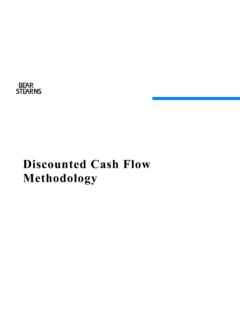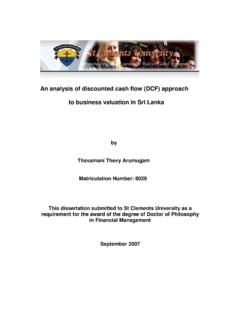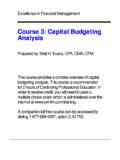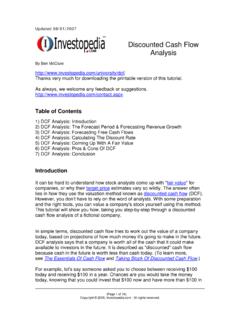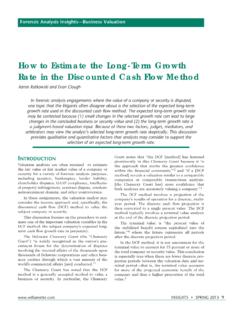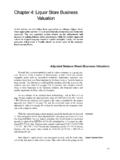Transcription of An Introduction to Real Estate Investment Analysis
1 AN Introduction TO real Estate Investment Analysis : A TOOL KIT REFERENCE FOR PRIVATE INVESTORS Rules of thumb and financial Analysis tools are critical for real Estate professionals. They provide the basic building blocks needed to understand appraisals and valuations, to compare Investment opportunities, to monitor and manage Investment results, to set asking prices, and to negotiate various real Estate based transactions (including purchase and sale agreements, mortgages and leases). These tools can be as simple or as sophisticated as you want them to be. The purpose of this article is to provide a basic Introduction to real Estate Investment Analysis tools for private investors so you can consider how they might apply to your Investment activities, can appreciate their meaning and significance if they come up in your business dealings, and can have glossary to refer to as needed.
2 Please note that the tools discussed in this article apply mostly to income properties, but can apply to vacant land as well. Also, while this article focuses on the purchase and sale of real properties, many of these tools and concepts can apply to leasing situations and negotiations between landlord and tenant. No Single Right Answer By way of background, there are several things you should keep in mind in considering or using these tools: There is no such thing as a typical investor. Every investor is unique. Take time to understand your unique requirements, and update them from time to time. There is no such thing as a typical property. The great thing about real Estate is that every property and every market truly is unique. Again, take time to understand the unique attributes of the properties you are considering, and revisit them from time to time.
3 Investment value and market value are not the same thing. Investment value is unique to you. Market value is based on the typical investor, which we know does not really exist. You need to consider the Investment value perspective of all the other players at your table, including your lender, buyer, seller, landlord, tenant, or competitors. The Investment value to one is not necessarily the same Investment value to another. 1 Phil Thompson Business Lawyer, Corporate Counsel There is no single, right rate of return. Acceptable rates of return usually fall within a range, depending on each investor s perspective of the risks associated with an Investment as compared to alternate or competitive investments, the investor s perceived ability to manage the risk, and the needs of their portfolio. There is no single, right price or point of value. Again, there is really only a range of values depending on investor perspective.
4 A good understanding of the basic financial Analysis tools, the market you are participating in, and the investor perspective of the other parties at the table, combined with a reasonable degree of flexibility, are essential skills for you to develop if you are going to be successful real Estate investor. At the end of the day, these skills should enable you to advocate different risk perspectives for different deals, and reflect those perspectives in rates of return and value propositions that support your Investment objectives. No Single Perfect Tool Just as there is no single, right answer to an Investment Analysis problem, there is no single perfect tool to use in analyzing real Estate opportunities. There are many tools to assess value and performance. Do not get overwhelmed by them. Learn the simplest ones, and try more sophisticated ones as you get more comfortable and find what works for you.
5 A tool s greatest value is simply in using it. Using these tools will help smoke out risks and key factors, will help define your comfort zones, and will develop your market knowledge and expertise. As is often the case in business, the process of doing the work can contribute more to a successful outcome than the actual work product itself. A tool s next highest value is in comparison to other tools. You can use tools to test their results against each other. Understanding why results differ with differ tools will improve your sophistication in financial Analysis generally, and your understanding of the particular Investment being considered. Financial Analysis tools vary across a number of key factors. The major ones include: - Simplicity vs. complexity. - Fast vs. time consuming. - Fixed point in time vs. period of time. - Static vs. dynamic. - Minimal assumptions vs.
6 Many assumptions. - Investor perspective vs. market perspective. - Pre-tax vs. after-tax. - Profit vs. cash flow. 2 Make sure you keep aware of exactly what you are measuring and what the limitations are in each case. A Word on Investment Calculators The digital age has brought Investment financial Analysis tools to everyone s fingertips. There are many financial calculators that will instantly produce the most sophisticated results based on inputs you make. Buying one and learning how to use it will make these tools far more accessible, and could even be a competitive advantage when engaged in a heated, parking lot negotiation. A Word on Investment Worksheets The same comment applies to Investment worksheets. Microsoft Excel and other programs give you the power to develop your own templates and worksheets to quickly and accurately perform sophisticated Analysis and calculations based on many changeable variables.
7 These sorts of tools not only enhance your sophistication as an investor, but also enable you to move quickly and decisively in negotiations. Notebook computers make these tools portable and accessible almost any time and anywhere. Some common worksheets which you can develop for yourself, or access as templates from the Internet and other sources, include: Property Analysis Worksheet: A single year income and expense statement for a property, which can show owner-actual, investor-projected and typical-market income and expense figures. They typically include: potential rental income, operating expenses including vacancy rates, net operating income, debt service assumptions and cash flow before taxes. They are often used with the Rules of Thumb and Direct Capitalization Tools discussed below, where net operating income is the key to your negotiation or Analysis .
8 Operations Cash Flow Worksheet: These are usually multi-year before tax and after tax cash flow Analysis covering a selected hold period. They are often used with Discounted Cash Flow Tools, and have the benefit of being after tax based. After all, it is not what you make but what you keep that really matters in any Investment portfolio, and we know that real Estate opportunities have some tax planning opportunities that other investments do not. Sale Proceeds Cash Flow Worksheet: This is a before tax and after tax sale proceeds Analysis based on an anticipated disposition of your Investment . It takes sale expenses, recaptured capital cost allowance, capital gains tax, mortgage payouts, and post-closing after tax cash flow to seller, into account. It is often used with the Operations Cash Flow Worksheet, as part of the most sophisticated Discounted Cash Flow Tools.
9 3 Lease Cash Flow Worksheet: An operations cash flow worksheet from a landlord and tenant perspectives. Can be set up to take moving costs, landlord incentives, and similar one-time expenditures into account. Again, it can be a before-tax or after-tax statement, allowing for return on Investment calculations and negotiations. Introducing The Tools: Three Broad Categories There are three broad categories of Investment Analysis tools in the real Estate context, all of which are explained in an introductory way below: Rules of Thumb: Their main advantages are that they are simple, fast and usually market based or market verifiable. Their main disadvantages are that they are static, usually one-time or single year based, and pre-tax. However, some of them will take equity growth into account. Direct Capitalization: These tools capitalize net income. They are more sophisticated than most Rules of Thumb, are dynamic in that they can handle a number of variables, and can be multi-year.
10 However, they are usually profit not cash flow based, are usually pre-tax, and often do not fully account for equity growth. Discounted Cash Flows: These tools discount and compound cash flows, resulting in the present value of future cash flow streams. They are the most sophisticated tools commonly found in the private real Estate market, making them harder to use but more enlightening. They also require the most assumptions, and are projected over a number of years, leading to serious questions about their certainty. Nevertheless, they remain the tools of choice among many institutional investors. Tool Kit #1 - Rules of Thumb Rules of Thumb are simple and fast to use, with comparatively few assumptions. On the other hand, they are usually pre-tax, static snapshots at a point in time. The most common Rules of Thumb are as follows: Gross Income Multipliers = Sale Price Gross Operating Income; another common one is Sale Price Number of Units Can be monthly or annual most often annual.


